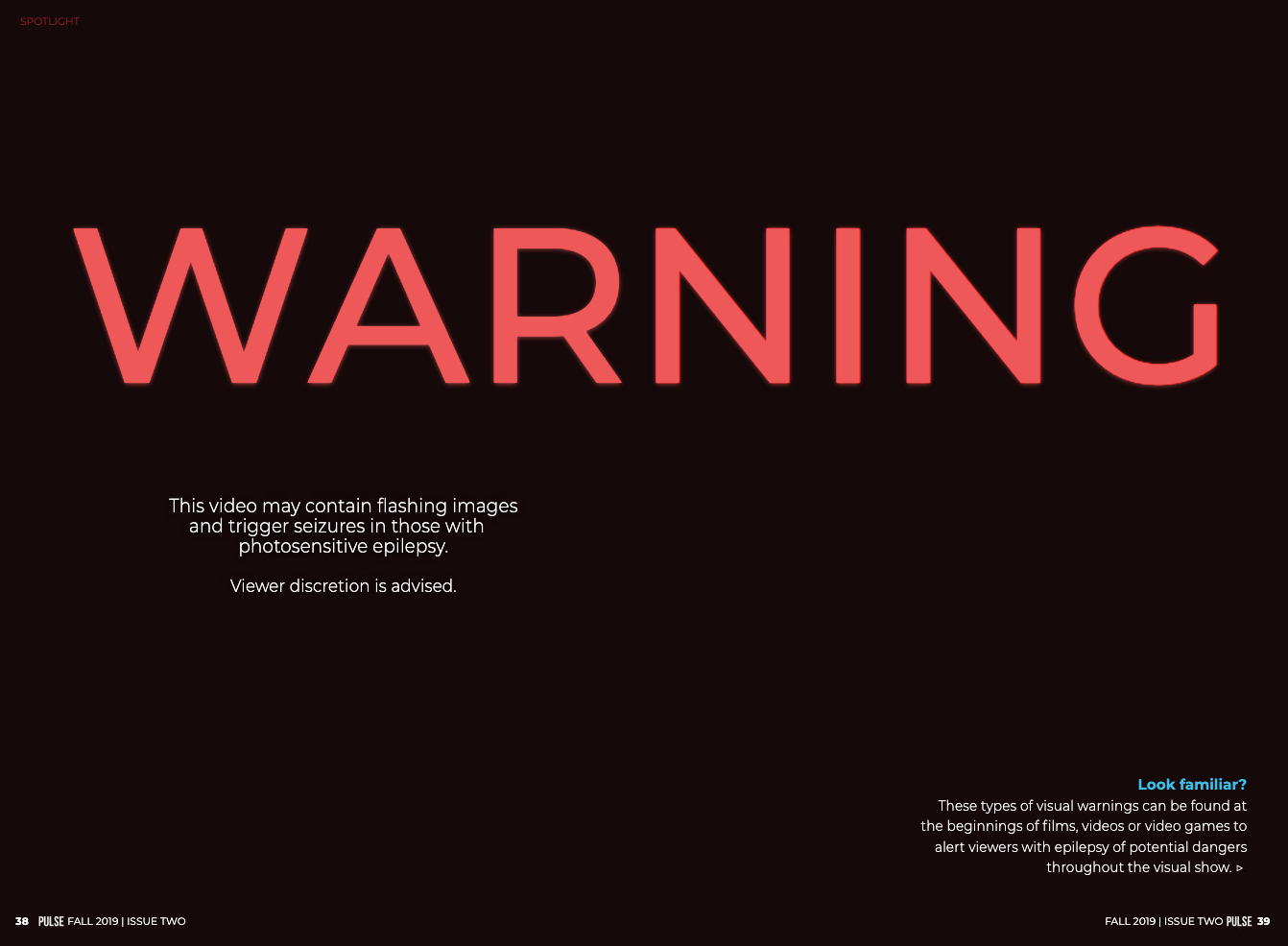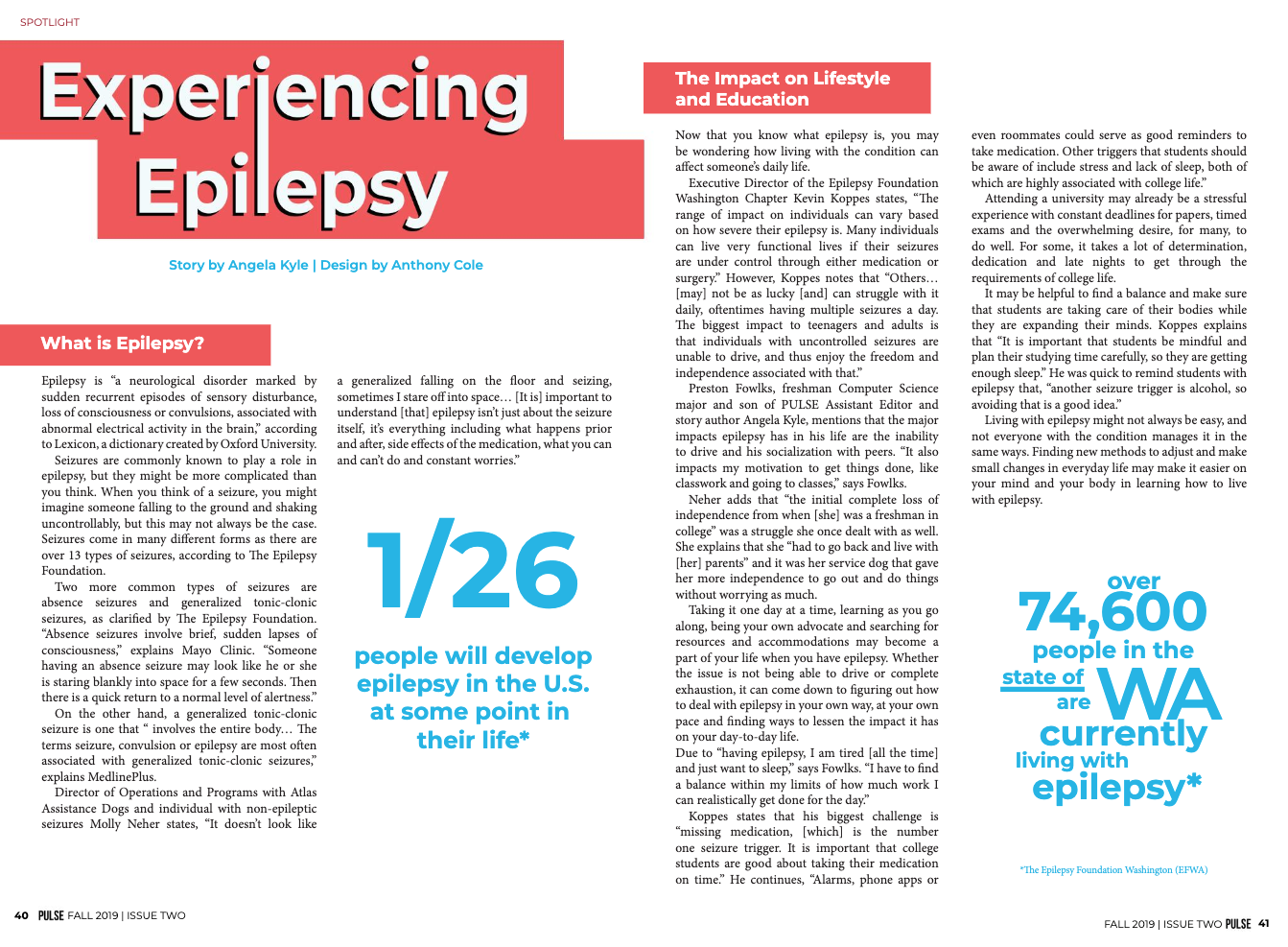Experiencing Epilepsy
Story by Angela Kyle | Design by Anthony Cole
WARNING: This video may contain flashing images and trigger seizures in those with photosensitive epilepsy. Viewer discretion is advised.
Sound familiar? These types of warnings can be found at the beginnings of videos, films or video games to alert viewers with epilepsy of potential dangers throughout the visual show.
What is Epilepsy?
Joseph Sirven, Editor-in-Chief of Epilepsy.com and former Director of Education for MayoClinic’s Arizona campus, states that “one in twenty-six people will develop epilepsy in the United States at some point in their time.” The Epilepsy Foundation Washington (EFWA) also reports that 74,600 people in the state of Washington are currently living with epilepsy.
Epilepsy is “a neurological disorder marked by sudden recurrent episodes of sensory disturbance, loss of consciousness or convulsions, associated with abnormal electrical activity in the brain,” according to Lexicon.
Seizures are commonly known to play a role in epilepsy, but they might be more complicated than you may think. When you think of a seizure, you might imagine someone falling to the ground and shaking uncontrollably, but this may not always be the case. Seizures come in many different forms as there are over 13 types of seizures, according to The Epilepsy Foundation.
Two more common types of seizures are absence seizures or generalized tonic-clonic seizures, as clarified by The Epilepsy Foundation. “Absence seizures involve brief, sudden lapses of consciousness,” explains MayoClinic. “Someone having an absence seizure may look like he or she is staring blankly into space for a few seconds. Then, there is a quick return to a normal level of alertness.”
On the other hand, a generalized tonic-clonic seizure is one that “ involves the entire body… The terms seizure, convulsion or epilepsy are most often associated with generalized tonic-clonic seizures,” explains MedlinePlus.
Molly Neher, Director of Operations and Programs with Atlas Assistance Dogs and someone with non-epileptic seizures states, “It doesn’t look like a generalized falling on the floor and seizing, sometimes I stare off into space.” Neher also emphasizes that it is “important to understand is epilepsy isn’t just about the seizure itself, it’s everything including what happens prior and after, side effects of the medication, what you can and can’t do and constant worries.”
Now that you know what epilepsy is, you may be wondering how living with the condition can affect someone’s daily life.
The Impact of Living with Epilepsy
Kevin Koppes, Executive Director of the Epilepsy Foundation Washington Chapter states, “The range of impact on individuals can vary based on how severe their epilepsy is. Many individuals can live very functional lives if their seizures are under control through either medication or surgery.” However, Koppes notes that “Others… [may] not be as lucky [and] can struggle with it daily, oftentimes having multiple seizures a day. The biggest impact to teenagers and adults is that individuals with uncontrolled seizures are unable to drive, and thus enjoy the freedom and independence associated with that.”
Preston Fowlks, freshman Computer Science major and son of PULSE Event Planner Angela Kyle, mentions that the major impacts epilepsy has in his life are the inability to drive and his socialization with peers. “It also impacts my motivation to get things done, like classwork and going to classes,” says Fowlks.
Similarly, Neher explains, “the initial complete loss of independence from when [she] was a freshman in college” was a struggle she once dealt with as well. She adds that she “had to go back and live with [her] parents” and it was her service dog that gave her more independence to go out and do things without worrying as much.
Taking it one day at a time, learning as you go along, being your own advocate and searching for resources and accommodations may become a part of your life when you have epilepsy. Whether the issue is not being able to drive or complete exhaustion, it can come down to figuring out how to deal with epilepsy in your own way, at your own pace and finding ways to lessen the impact it has on your day-to-day life.
Challenges of Being a Student With Epilepsy
“Having epilepsy, I am tired [all the time] and just want to sleep,” says Fowlks. “I have to find a balance within my limits of how much work I can realistically get done for the day.”
Koppes states that his biggest challenge is “missing medication, [which] is the number one seizure trigger. It is important that college students are good about taking their medication on time.” He continues, “Alarms, phone apps or even roommates could serve as good reminders to take medication. Other triggers that students should be aware of include stress and lack of sleep, both of which are highly associated with college life.”
Attending a university may already be a stressful experience with constant deadlines for papers, timed exams and the overwhelming desire, for many, to do well. For some, it takes a lot of determination, dedication and late nights to get through the requirements of college life.
It may be helpful to find a balance and make sure that students are taking care of their bodies while they are expanding their minds. Koppes explains that “It is important that students be mindful and plan their studying time carefully, so they are getting enough sleep.” He was quick to remind students with epilepsy that, “another seizure trigger is alcohol, so avoiding that is a good idea.”
Living with epilepsy might not always be easy, and not everyone with the condition manages it in the same ways. Finding new methods to adjust and make small changes in everyday life, may make it easier on your mind and your body in learning how to live with epilepsy.


